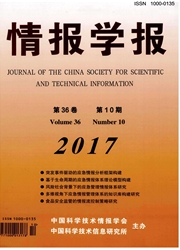

 中文摘要:
中文摘要:
知识网络是一种具有层次结构的复杂网络,将社会网络分析方法应用于知识网络分析时,需要结合知识节点间、知识关联问的语义差异,以深入探究知识网络的层次结构和微观形态。以“数字图书馆”领域为例,在可靠关联基础上构建一个更全面、简洁的共词网络,该网络表现出明显的层次结构。以k-core为参数进行网络子层分解,再以聚类系数、平均密度为参数对网络子层进行融合,可将整体网络归纳为基础层、细节层和中间层。基础层是知识网络的内核,可用于划分领域的主要研究方向;细节层由多个独立的子知识群构成,代表领域内研究的具体内容,可用于揭示知识网络的微观形态;中间层介于两者之间,可用于揭示领域知识深化的路径和分化、交叉衍生的形式。对知识网络层次结构的揭示,有利于在当前复杂网络研究背景下重新发挥图情学科在知识组织方面的传统优势。
 英文摘要:
英文摘要:
The knowledge network is a complex network with hierarchical structure, social network analysis methods are commonly used in the analysis of knowledge networks. When researching knowledge network based on social network analysis methods, we should pay attention to the differences between knowledge nodes and the differences between knowledge relations, so as to deeply exploring the structure and morphology of knowledge networks. A more comprehensive and concise knowledge network of "digital libraries" is construct based on reliable co-word relations of keywords. After a k- core decomposing of it, we calculated the clustering coefficient and density of each k-shell. The results show that the network can be divided into three layers: the base layer is the core of network and can be used to reveal the main research directions; the detail layer contains multiple independent subgroups which represent the specific research contents of the field, so it can be used to reveal the knowledge network' s micro-morphology; the middle layer ranged between the above two can be used to reveal the path to deepen knowledge and the way of knowledge differentiation and cross-derivative.
 同期刊论文项目
同期刊论文项目
 同项目期刊论文
同项目期刊论文
 期刊信息
期刊信息
